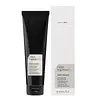What's inside
What's inside
 Key Ingredients
Key Ingredients

No key ingredients
 Benefits
Benefits

 Concerns
Concerns

 Ingredients Side-by-side
Ingredients Side-by-side

Water
Skin ConditioningGlycerin
HumectantSodium Cocoyl Isethionate
CleansingBetaine
HumectantStearic Acid
CleansingGlyceryl Stearate Citrate
EmollientPentylene Glycol
Skin ConditioningDecyl Glucoside
CleansingDisodium Cocoamphodiacetate
CleansingCoconut Acid
CleansingSodium Lauroyl Glutamate
Juniperus Virginiana Oil
MaskingSclerotium Gum
Emulsion StabilisingSodium Isethionate
CleansingButylene Glycol
HumectantChlorphenesin
AntimicrobialPolyquaternium-10
Juniperus Communis Fruit Oil
MaskingSodium Chloride
MaskingSpinacia Oleracea Leaf Extract
Skin ConditioningPropanediol
SolventMyrtus Communis Extract
AstringentCarnosine
Skin ConditioningCoriandrum Sativum Seed Oil
EmollientLinalool
PerfumingLimonene
PerfumingCitric Acid
BufferingCedrus Atlantica Bark Oil
MaskingPelargonium Graveolens Oil
MaskingTephrosia Purpurea Seed Extract
Skin ConditioningElettaria Cardamomum Seed Extract
PerfumingSodium Benzoate
MaskingPotassium Sorbate
PreservativeJasminum Grandiflorum Flower Extract
MaskingWater, Glycerin, Sodium Cocoyl Isethionate, Betaine, Stearic Acid, Glyceryl Stearate Citrate, Pentylene Glycol, Decyl Glucoside, Disodium Cocoamphodiacetate, Coconut Acid, Sodium Lauroyl Glutamate, Juniperus Virginiana Oil, Sclerotium Gum, Sodium Isethionate, Butylene Glycol, Chlorphenesin, Polyquaternium-10, Juniperus Communis Fruit Oil, Sodium Chloride, Spinacia Oleracea Leaf Extract, Propanediol, Myrtus Communis Extract, Carnosine, Coriandrum Sativum Seed Oil, Linalool, Limonene, Citric Acid, Cedrus Atlantica Bark Oil, Pelargonium Graveolens Oil, Tephrosia Purpurea Seed Extract, Elettaria Cardamomum Seed Extract, Sodium Benzoate, Potassium Sorbate, Jasminum Grandiflorum Flower Extract
Water
Skin ConditioningDisodium Laureth Sulfosuccinate
CleansingOctyldodecanol
EmollientPolyacrylate-33
Propanediol
SolventPolyglyceryl-2 Caprate
EmulsifyingSodium Cocoyl Isethionate
CleansingMontmorillonite
AbsorbentKaolin
AbrasiveOlive Oil Polyglyceryl-6 Esters
EmollientRice Oil Glycereth-8 Esters
CleansingPhospholipids
Skin ConditioningSodium Lauroamphoacetate
CleansingBisabolol
MaskingPentylene Glycol
Skin ConditioningSodium Chloride
MaskingSodium Phytate
Caprylyl Glycol
EmollientDehydroacetic Acid
PreservativeBenzoic Acid
MaskingPropylene Carbonate
SolventLinalool
PerfumingFarnesol
PerfumingWater, Disodium Laureth Sulfosuccinate, Octyldodecanol, Polyacrylate-33, Propanediol, Polyglyceryl-2 Caprate, Sodium Cocoyl Isethionate, Montmorillonite, Kaolin, Olive Oil Polyglyceryl-6 Esters, Rice Oil Glycereth-8 Esters, Phospholipids, Sodium Lauroamphoacetate, Bisabolol, Pentylene Glycol, Sodium Chloride, Sodium Phytate, Caprylyl Glycol, Dehydroacetic Acid, Benzoic Acid, Propylene Carbonate, Linalool, Farnesol
 Reviews
Reviews

Ingredients Explained
These ingredients are found in both products.
Ingredients higher up in an ingredient list are typically present in a larger amount.
Linalool is a fragrance and helps add scent to products. It's derived from common plants such as cinnamon, mint, citrus, and lavender.
Like Limonene, this ingredient oxidizes when exposed to air. Oxidized linalool can cause allergies and skin sensitivity.
This ingredient has a scent that is floral, spicy tropical, and citrus-like.
Learn more about LinaloolPentylene glycol is typically used within a product to thicken it. It also adds a smooth, soft, and moisturizing feel to the product. It is naturally found in plants such as sugar beets.
The hydrophilic trait of Pentylene Glycol makes it a humectant. As a humectant, Pentylene Glycol helps draw moisture from the air to your skin. This can help keep your skin hydrated.
This property also makes Pentylene Glycol a great texture enhancer. It can also help thicken or stabilize a product.
Pentylene Glycol also acts as a mild preservative and helps to keep a product microbe-free.
Some people may experience mild eye and skin irritation from Pentylene Glycol. We always recommend speaking with a professional about using this ingredient in your routine.
Pentylene Glycol has a low molecular weight and is part of the 1,2-glycol family.
Learn more about Pentylene GlycolPropanediol is an all-star ingredient. It softens, hydrates, and smooths the skin.
It’s often used to:
Propanediol is not likely to cause sensitivity and considered safe to use. It is derived from corn or petroleum with a clear color and no scent.
Learn more about PropanediolChances are, you eat sodium chloride every day. Sodium Chloride is also known as table salt.
This ingredient has many purposes in skincare: thickener, emulsifier, and exfoliator.
You'll most likely find this ingredient in cleansers where it is used to create a gel-like texture. As an emulsifier, it also prevents ingredients from separating.
There is much debate on whether this ingredient is comedogenic. The short answer - comedogenic ratings don't tell the whole story. Learn more about comegodenic ratings here.
The concensus about this ingredient causing acne seems to be divided. Research is needed to understand if this ingredient does cause acne.
Scrubs may use salt as the primary exfoliating ingredient.
Learn more about Sodium ChlorideSodium cocoyl isethionate is a natural ingredient from coconut oil. It is an ultra gentle cleanser that gives a nice foam without drying the skin or impacting the skin barrier.
The amount of foam created depends on the amount of sodium cocoyl isethionate used in the product.
This ingredient also helps improve the spreadability of a product.
Learn more about Sodium Cocoyl IsethionateWater. It's the most common cosmetic ingredient of all. You'll usually see it at the top of ingredient lists, meaning that it makes up the largest part of the product.
So why is it so popular? Water most often acts as a solvent - this means that it helps dissolve other ingredients into the formulation.
You'll also recognize water as that liquid we all need to stay alive. If you see this, drink a glass of water. Stay hydrated!
Learn more about Water